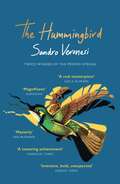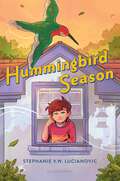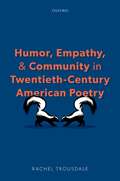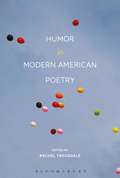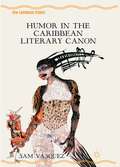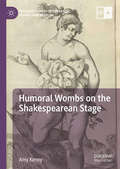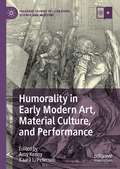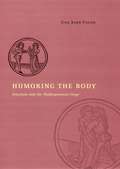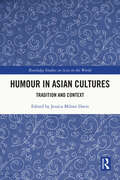- Table View
- List View
The Hummingbird
by Kati HiekkapeltoShortlisted for the Petrona Award for Best Scandinavian Crime NovelAnna Fekete, who fled the Yugoslavian wars as a child, has just started working as a criminal investigator in a northern Finnish coastal town, when she is thrust into a rolling murder investigation. It doesn't help that her new partner, Esko, doesn't bother hiding his racist prejudices. Anna's work as a criminal investigator barely gets off the ground before she is thrust into a case that has riveted the nation. A young woman has been killed on a running trail, and a pendant depicting an Aztec god has been found in her possession. Another murder soon follows. All signs point to a serial killer. But can Anna catch the Hummingbird before he - or she - strikes again?Translated from the Finnish by David Hackston
The Hummingbird: ‘Masterly: a cabinet of curiosities and delights, packed with small wonders' (Ian McEwan)
by Sandro Veronesi'The kind of novel summer is made for: instantly immersive, playfully inventive, effortlessly wise... Comforting and hopeful'Observer'Masterly: a cabinet of curiosities and delights, packed with small wonders'Ian McEwan'Pulls off the extraordinary feat of making you believe he is writing for your ears alone'Howard Jacobson'A remarkable accomplishment, a true gift to the world'Michael Cunningham'Ardent, gripping, and inventive to the core'Jhumpa Lahiri'A spellbinding experience: clever, funny and deeply moving'Roddy DoyleMarco Carrera is 'the hummingbird,' a man with the almost supernatural ability to stay still as the world around him continues to change.As he navigates the challenges of life - confronting the death of his sister and the absence of his brother; taking care of his parents as they approach the end of their lives; raising his granddaughter when her mother, Marco's own child, can no longer be there for her; coming to terms with his love for the enigmatic Luisa - Marco Carrera comes to represent the quiet heroism that pervades so much of our everyday existence.A thrilling novel about the need to look to the future with hope and live with intensity to the very end.THE NO. 1 INTERNATIONAL BESTSELLEROver 300,000 copies soldSoon to be a major motion pictureWinner of the Premio StregaWinner of the Prix du Livre EtrangerBook of the Year for the Corriere della Sera
The Hummingbird and The Bear
by Nicholas HoggSam Taylor knows he should be content with his life; with a high-flying career in the city and a beautiful fiancée, his lot is better than most. But he can't help but feel something is missing.When Sam meets enigmatic American Kay at a Cotswolds wedding as he holds out his umbrella for her in the pouring rain, he believes he has found someone who completes him. Throwing caution to the wind, Sam decides to risk everything and pursue Kay across the Atlantic to her native New York and the home she shares with her husband, Chris. Nicholas Hogg's novel is a taut and highly charged story of passion and adultery.Set against the backdrop of the financial crisis, The Hummingbird and the Bear follows a powerful and illicit love from England to New York, from the known to the unknown. Both shocking and delightful, it confirms Hogg's position among the finest of today's young writers.Praise for his previois novel Show Me the Sky:"An assured and gripping debut." BBC Radio 3."Hogg performs a full range of literary circus feats... leading his reader on an exotic journey." Adelaide Advertiser. Like a four-part harmony, Hogg balances these voices, strengthening the book's message of staying true to one's roots. Sunday Herald"His subtle and clever novel weaves together five different narrative strands... plotted so artfully." The Big Issue.
Hummingbird Lake: A heartwarming, uplifting, feel-good romance series (Eternity Springs #2)
by Emily MarchFor fans of Robyn Carr, Barbara Freethy, Susan Mallery and Sheryl Woods. The delightful second novel in New York Times bestselling author Emily March's warm and uplifting romance series about a small town with a big heart. Haunted by painful memories, paediatric surgeon Sage Anderson gives up medicine and moves to Eternity Springs. There she finds a place to call home, but even her newfound success as a gifted artist isn't enough to keep her nightmares at bay. Colt Rafferty is about to change all that. Eternity Springs is a refuge for Colt, a place to ground himself when the stress of investigating tragedies takes its toll. He has come here for a little R & R, but instead of relaxing, he finds himself fascinated by the mysterious redhead whose secrets beg to be discovered - a beauty running from her past, a heartsick woman in desperate need of the sweet sanctuary of a devoted man's embrace. And he is just the man to show her the true path to peace - by offering her the healing power of love.Escape to Eternity Springs, a little piece of heaven in the Colorado Rockies, with the other books in the series, Hummingbird Lake, Heartache Falls, Mistletoe Mine, Lover's Leap, Nightingale Way, Reflection Point, Miracle Road, Dreamweaver Trail, Teardrop Lane, Heartsong Cottage, Reunion Pass, Christmas In Eternity Springs.
Hummingbird Salamander: A Novel
by Jeff VanderMeerA speculative thriller about the end of all things, set in an unnamed part of the Pacific Northwest. A harrowing descent into a secret world.
Hummingbird Season
by Stephanie V.W. LucianovicA poignant and necessary story about finding hope during difficult times, set in the early days of the Covid-19 pandemic.Archie's life--and the whole world--is turned upside down by Covid-19. Suddenly there are no more Friday night dinners out, no more going to school, no more hanging out with friends . . . no leaving the house at all. Even though he's inside with his family all day every day, Archie can't help but feel more alone than ever before. While everyone else seems to be adapting to their new normal just fine, it's like Archie is permanently on mute, unable to find the words to describe how he feels--and sometimes, unable to find someone who will listen. The bright spot of Archie's days at home is watching and learning about the hummingbirds that feed outside his windows. But just when it seems like this could be what brings his family together again, California experiences its worst wildfire in history, and Archie's favorite hummingbird disappears. In a time when hope is hard to hold on to, Archie must find his voice and find hope once again.Hummingbird Season is an honest and healing novel in verse documenting the early days of the Covid-19 pandemic and the things that bring us together when circumstances keep us apart.
The Hummingbird's Cage
by Tamara DietrichJoanna has spent ten years married to a monster. Everyone thinks she has the perfect life, but behind closed doors she lives in constant fear of her husband. Escape seems impossible - and then a stranger offers her a chance to flee. On the run with her young daughter, Joanna finds herself in the mysterious town of Morro. With no memory of how she got there. And no idea of what the town truly is. Joanna faces a rare and terrible choice - stay safe, or return to face the fight of her life, to save herself and her little girl.
The Hummingbird's Daughter: A Novel
by Luis Alberto Urrea'Extraordinary . . . deeply felt and beautifully told' ObserverIt is 1889. Civil war is brewing in Mexico, and sixteen-year-old Teresita has just woken from the strangest dream - a dream that she has died. Only it was not a dream. This passionate and rebellious young woman has arisen from death with a power to heal - but it will take all her faith to endure the trials that await her and her family now that she has become the Saint of Cabora.The Hummingbird's Daughter is the story of a girl and a country grappling with their destiny. Two decades in the writing, the result is an epic, dazzling novel of love and loss, joy and sacrifice.
Humor
by Stanley DonwoodThere was disaster coming; that was blindingly obvious. Life had been almost ridiculously easy, and now things were going to get worse. Much, much worse. I couldn't believe that I had ever thought otherwise. I couldn't believe that I'd ever thought that there could be any other outcome. Stanley Donwood's fictional universe is one in which anything can happen, and frequently does. Disappearances (people, things) are everyday. Relationships are unstable. Nature has turned unnatural. It's the kind of world (the kind of book) in which you might walk into a room only to find, that room, has ... no ... floor. A substantial selection of Stanley's fiction over the past ten years or so, (title) shows a contemporary master of the micro narrative. Apocalyptic, funny, unsettling and hallucinogenic in their intensity, Stanley Donwood's stories present a series of haunting episodes in a world drained of meaning, sense and consequence.
Humor and Masculinity in U.S. Fiction: Intersections, Performances, and Functions (Routledge Research in American Literature and Culture)
by Joseph L. CoulombeHumor and Masculinity in U.S. Fiction offers a pragmatic and theoretically informed model for analyzing how humor and gender intersect in key U.S. texts, bringing much-needed attention to the complex ways that humor can support and/or subvert reductive masculine codes and behaviors. Its argument builds upon three major humor theories – the incongruity theory, superiority theory, and relief theory – to analyze how humor is used to negotiate the shifting constructions of masculinity and manhood in American culture and literature. Focusing on explicit textual references to joking, pranks, and laughter, Humor and Masculinity in U.S. Fiction offers well-supported, original interpretations of works by Mark Twain, Owen Wister, Dorothy Parker, Zora Neale Hurston, Joseph Heller, Philip Roth, and Sherman Alexie. The primary goal of Humor and Masculinity in U.S. Fiction is to understand the multiple ways that humor performs and interrogates masculinity in seminal U.S. texts.
Humor and Masculinity in U.S. Fiction: Intersections, Performances, and Functions (Routledge Research in American Literature and Culture)
by Joseph L. CoulombeHumor and Masculinity in U.S. Fiction offers a pragmatic and theoretically informed model for analyzing how humor and gender intersect in key U.S. texts, bringing much-needed attention to the complex ways that humor can support and/or subvert reductive masculine codes and behaviors. Its argument builds upon three major humor theories – the incongruity theory, superiority theory, and relief theory – to analyze how humor is used to negotiate the shifting constructions of masculinity and manhood in American culture and literature. Focusing on explicit textual references to joking, pranks, and laughter, Humor and Masculinity in U.S. Fiction offers well-supported, original interpretations of works by Mark Twain, Owen Wister, Dorothy Parker, Zora Neale Hurston, Joseph Heller, Philip Roth, and Sherman Alexie. The primary goal of Humor and Masculinity in U.S. Fiction is to understand the multiple ways that humor performs and interrogates masculinity in seminal U.S. texts.
Humor, Empathy, and Community in Twentieth-Century American Poetry
by Rachel TrousdaleHumor, Empathy, and Community in Twentieth-Century American Poetry explores how American poets of the last hundred years have used laughter to create communities of readers and writers. For poets slightly outside of the literary or social mainstream, humor encourages mutual understanding and empathic insight among artist, audience, and subject. As a result, laughter helps poets reframe and reject literary, political, and discursive hierarchies—whether to overturn those hierarchies, or to place themselves at the top. While theorists like Freud and Bergson argue that laughter patrols and maintains the boundary between in-group and out-group, this volume shows how laughter helps us cross or re-draw those boundaries. Poets who practice such constructive humor promote a more democratic approach to laughter. Humor reveals their beliefs about their audiences and their attitudes toward the Romantic notion that poets are exceptional figures. When poets use humor to promote empathy, they suggest that poetry's ethical function is tied to its structure: empathy, humor, and poetry identify shared patterns among apparently disparate objects. This book explores a broad range of serious approaches to laughter: the inclusive, community-building humor of W. H. Auden and Marianne Moore; the self-aggrandizing humor of Ezra Pound; the self-critical humor of T. S. Eliot; Sterling Brown's antihierarchical comedy; Elizabeth Bishop's attempts to balance mockery with sympathy; and the comic epistemologies of Lucille Clifton, Stephanie Burt, Cathy Park Hong, and other contemporary poets. It charts a developing poetics of laughter in the twentieth and twenty-first centuries, showing how humor can be deployed to embrace, to exclude, and to transform.
Humor, Empathy, and Community in Twentieth-Century American Poetry
by Rachel TrousdaleHumor, Empathy, and Community in Twentieth-Century American Poetry explores how American poets of the last hundred years have used laughter to create communities of readers and writers. For poets slightly outside of the literary or social mainstream, humor encourages mutual understanding and empathic insight among artist, audience, and subject. As a result, laughter helps poets reframe and reject literary, political, and discursive hierarchies—whether to overturn those hierarchies, or to place themselves at the top. While theorists like Freud and Bergson argue that laughter patrols and maintains the boundary between in-group and out-group, this volume shows how laughter helps us cross or re-draw those boundaries. Poets who practice such constructive humor promote a more democratic approach to laughter. Humor reveals their beliefs about their audiences and their attitudes toward the Romantic notion that poets are exceptional figures. When poets use humor to promote empathy, they suggest that poetry's ethical function is tied to its structure: empathy, humor, and poetry identify shared patterns among apparently disparate objects. This book explores a broad range of serious approaches to laughter: the inclusive, community-building humor of W. H. Auden and Marianne Moore; the self-aggrandizing humor of Ezra Pound; the self-critical humor of T. S. Eliot; Sterling Brown's antihierarchical comedy; Elizabeth Bishop's attempts to balance mockery with sympathy; and the comic epistemologies of Lucille Clifton, Stephanie Burt, Cathy Park Hong, and other contemporary poets. It charts a developing poetics of laughter in the twentieth and twenty-first centuries, showing how humor can be deployed to embrace, to exclude, and to transform.
Humor in Modern American Poetry
by Rachel TrousdaleModern poetry, at least according to the current consensus, is difficult and often depressing. But as Humor in Modern American Poetry shows, modern poetry is full of humorous moments, from comic verse published in popular magazines to the absurd juxtapositions of The Cantos. The essays in this collection show that humor is as essential to the serious work of William Carlos Williams as it is to the light verse of Phyllis McGinley. For the writers in this volume, the point of humor is not to provide “comic relief,” a brief counterpoint to the poem's more serious themes; humor is central to the poems' projects. These poets use humor to claim their own poetic authority; to re-define literary tradition; to show what audience they are writing for; to make political attacks; and, perhaps most surprisingly, to promote sympathy among their readers. The essays in this book include single-author studies, discussions of literary circles, and theories of form. Taken together, they help to begin a new conversation about modernist poetry, one that treats its lighthearted moments not as decorative but as substantive. Humor defines groups and marks social boundaries, but it also leads us to transgress those boundaries; it forges ties between the writer and the reader, blurs the line between public and private, and becomes a spur to self-awareness.
Humor in Modern American Poetry
by Rachel TrousdaleModern poetry, at least according to the current consensus, is difficult and often depressing. But as Humor in Modern American Poetry shows, modern poetry is full of humorous moments, from comic verse published in popular magazines to the absurd juxtapositions of The Cantos. The essays in this collection show that humor is as essential to the serious work of William Carlos Williams as it is to the light verse of Phyllis McGinley. For the writers in this volume, the point of humor is not to provide “comic relief,” a brief counterpoint to the poem's more serious themes; humor is central to the poems' projects. These poets use humor to claim their own poetic authority; to re-define literary tradition; to show what audience they are writing for; to make political attacks; and, perhaps most surprisingly, to promote sympathy among their readers. The essays in this book include single-author studies, discussions of literary circles, and theories of form. Taken together, they help to begin a new conversation about modernist poetry, one that treats its lighthearted moments not as decorative but as substantive. Humor defines groups and marks social boundaries, but it also leads us to transgress those boundaries; it forges ties between the writer and the reader, blurs the line between public and private, and becomes a spur to self-awareness.
Humor in the Caribbean Literary Canon (New Caribbean Studies)
by S. VásquezHumor in the Caribbean Literary Canon intimately examines Caribbean writers who engage canonical Western texts and forms, while using humor to challenge Western representations of people of African descent.
Humoral Wombs on the Shakespearean Stage (Palgrave Studies in Literature, Science and Medicine)
by Amy KennyThis book explores how the humoral womb was evoked, enacted, and embodied on the Shakespearean stage by considering the intersection of performance studies and humoral theory. Galenic naturalism applied the four humors—yellow bile, black bile, phlegm, and blood—to delineate women as porous, polluting, and susceptible to their environment. This book draws on early modern medical texts to provocatively demonstrate how Shakespeare’s canon offers a unique agency to female characters via humoral discourse of the womb. Chapters discuss early modern medicine’s attempt to theorize and interpret the womb, specifically its role in disease, excretion, and conception, alongside passages of Shakespeare’s plays to offer a fresh reading of (geo)humoral subjectivity. The book shows how Shakespeare subversively challenges contemporary notions of female fluidity by accentuating the significance of the womb as a source of self-defiance and autonomy for female characters across his canon.
Humorality in Early Modern Art, Material Culture, and Performance (Palgrave Studies in Literature, Science and Medicine)
by Amy Kenny Kaara L. PetersonHumorality in Early Modern Art, Material Culture, and Performance seeks to address the representation of the humors from non-traditional, abstract, and materialist perspectives, considering the humorality of everyday objects, activities, and performance within the early modern period. To uncover how humoralism shapes textual, material, and aesthetic encounters for contemporary subjects in a broader sense than previous studies have pursued, the project brings together three principal areas of investigation: how the humoral body was evoked and embodied within the space of the early modern stage; how the materiality of an object can be understood as constructed within humoral discourse; and how individuals’ activities and pursuits can connote specific practices informed by humoralism. Across the book, contributors explore how diverse media and cultural practices are informed by humoralism. As a whole, the collection investigates alternative humoralities in order to illuminate both early modern works of art as well as the cultural moments of their production.
Humoring the Body: Emotions and the Shakespearean Stage
by Gail Kern PasterThough modern readers no longer believe in the four humors of Galenic naturalism—blood, choler, melancholy, and phlegm—early modern thought found in these bodily fluids key to explaining human emotions and behavior. In Humoring the Body, Gail Kern Paster proposes a new way to read the emotions of the early modern stage so that contemporary readers may recover some of the historical particularity in early modern expressions of emotional self-experience. Using notions drawn from humoral medical theory to untangle passages from important moral treatises, medical texts, natural histories, and major plays of Shakespeare and his contemporaries, Paster identifies a historical phenomenology in the language of affect by reconciling the significance of the four humors as the language of embodied emotion. She urges modern readers to resist the influence of post-Cartesian abstraction and the disembodiment of human psychology lest they miss the body-mind connection that still existed for Shakespeare and his contemporaries and constrained them to think differently about how their emotions were embodied in a premodern world.
Humoring the Body: Emotions and the Shakespearean Stage
by Gail Kern PasterThough modern readers no longer believe in the four humors of Galenic naturalism—blood, choler, melancholy, and phlegm—early modern thought found in these bodily fluids key to explaining human emotions and behavior. In Humoring the Body, Gail Kern Paster proposes a new way to read the emotions of the early modern stage so that contemporary readers may recover some of the historical particularity in early modern expressions of emotional self-experience. Using notions drawn from humoral medical theory to untangle passages from important moral treatises, medical texts, natural histories, and major plays of Shakespeare and his contemporaries, Paster identifies a historical phenomenology in the language of affect by reconciling the significance of the four humors as the language of embodied emotion. She urges modern readers to resist the influence of post-Cartesian abstraction and the disembodiment of human psychology lest they miss the body-mind connection that still existed for Shakespeare and his contemporaries and constrained them to think differently about how their emotions were embodied in a premodern world.
Humoring the Body: Emotions and the Shakespearean Stage
by Gail Kern PasterThough modern readers no longer believe in the four humors of Galenic naturalism—blood, choler, melancholy, and phlegm—early modern thought found in these bodily fluids key to explaining human emotions and behavior. In Humoring the Body, Gail Kern Paster proposes a new way to read the emotions of the early modern stage so that contemporary readers may recover some of the historical particularity in early modern expressions of emotional self-experience. Using notions drawn from humoral medical theory to untangle passages from important moral treatises, medical texts, natural histories, and major plays of Shakespeare and his contemporaries, Paster identifies a historical phenomenology in the language of affect by reconciling the significance of the four humors as the language of embodied emotion. She urges modern readers to resist the influence of post-Cartesian abstraction and the disembodiment of human psychology lest they miss the body-mind connection that still existed for Shakespeare and his contemporaries and constrained them to think differently about how their emotions were embodied in a premodern world.
Humour in Asian Cultures: Tradition and Context (Routledge Studies on Asia in the World)
by Jessica Milner DavisThis innovative book traces the impact of tradition on modern humour across several Asian countries and their cultures. Using examples from Japan, Korea, Indonesia and Chinese cultures in Mainland China, Hong Kong and Taiwan, the contributors explore the different cultural rules for creating and sharing humour. Humour can be a powerful lubricant when correctly interpreted; mis-interpreted, it is likely to cause considerable setbacks. Over time, it has emerged and submerged in different periods and different forms in all these countries but today’s conventions still reflect traditional attitudes to and assumptions about what is appropriate in creating and using humour. Under close examination, Milner Davis and her colleagues show how forms and conventions that differ from those in the west can also be seen to possess elements in common. With examples including Mencian and other classical texts, Balinese traditional verbal humour, Korean and Taiwanese workplace humour, Japanese laughter ceremonies, performances and cartoons, as well as contemporary Chinese-language films and videos, they engage with a wide range of forms and traditions. This fascinating collection of studies will be of great interest to students and scholars of many Asian cultures, and also to those with a broader interest in humour studies. It highlights the increasing importance of understanding a wider range of cultural values in the present era of globalized communication and the importance of reliable studies of why and how cultures that are geographically related differ in their traditional uses of and assumptions about humour.
Humour in Asian Cultures: Tradition and Context (Routledge Studies on Asia in the World)
by Jessica Milner DavisThis innovative book traces the impact of tradition on modern humour across several Asian countries and their cultures. Using examples from Japan, Korea, Indonesia and Chinese cultures in Mainland China, Hong Kong and Taiwan, the contributors explore the different cultural rules for creating and sharing humour. Humour can be a powerful lubricant when correctly interpreted; mis-interpreted, it is likely to cause considerable setbacks. Over time, it has emerged and submerged in different periods and different forms in all these countries but today’s conventions still reflect traditional attitudes to and assumptions about what is appropriate in creating and using humour. Under close examination, Milner Davis and her colleagues show how forms and conventions that differ from those in the west can also be seen to possess elements in common. With examples including Mencian and other classical texts, Balinese traditional verbal humour, Korean and Taiwanese workplace humour, Japanese laughter ceremonies, performances and cartoons, as well as contemporary Chinese-language films and videos, they engage with a wide range of forms and traditions. This fascinating collection of studies will be of great interest to students and scholars of many Asian cultures, and also to those with a broader interest in humour studies. It highlights the increasing importance of understanding a wider range of cultural values in the present era of globalized communication and the importance of reliable studies of why and how cultures that are geographically related differ in their traditional uses of and assumptions about humour.
Humour in British First World War Literature: Taming the Great War
by Emily AndersonThis book explores how humorous depictions of the Great War helped to familiarise, domesticate and tame the conflict. In contrast to the well-known First World War literature that focuses on extraordinary emotional disruption and the extremes of war, this study shows other writers used humour to create a gentle, mild amusement, drawing on familiar, popular genres and forms used before 1914. Emily Anderson argues that this humorous literature helped to transform the war into quotidian experience. Based on little-known primary material uncovered through detailed archival research, the book focuses on works that, while written by celebrated authors, tend not to be placed in the canon of Great War literature. Each chapter examines key examples of literary texts, ranging from short stories and poetry, to theatre and periodicals. In doing so, the book investigates the complex political and social significance of this tame style of humour.
Humour in Iran: Eleven-hundred Years of Satire and Humour in Persian Literature
by Homa KatouzianSatire, irony and humour have long been features of Persian literature's rich tradition, taking various forms from the coarse and obscene to the subtle and refined. Humour in Iran is a close and comprehensive study of satire and humour – in verse as well as prose – over the eleven-hundred years since the emergence of classical Persian literature. Combining Persian original texts with their English translations, it covers a range of texts and authors, from the lampoon in Ferdowsi's great epic of the ancient kings in the tenth century, through such master satirists as Obeyd Zakani, Sa'di, Rumi, Khayyam, Hafiz, Anvari, Sana'i, Khaqani, Suzani, Qa'ani, Yaghma, and so on. The book also includes twentieth century authors such as Iraj, Dehkhoda, Bahar, Eshqi, Aref, Hedayat, Jamalzadeh, Al-e Ahmad and more. A must read for scholars and students of humour and satire as well as Persian literature and Middle Eastern studies, and it will also appeal to general readers interested in ribald humour and satire.

